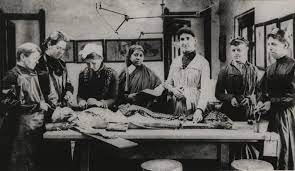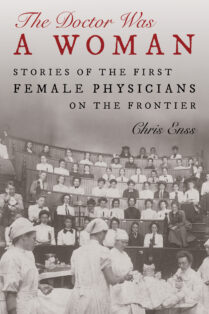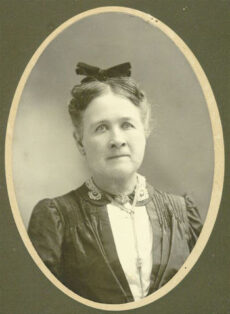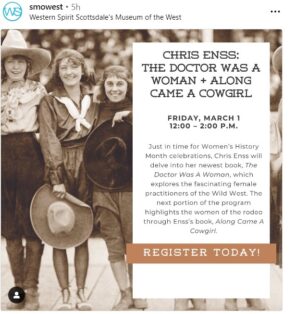1863 – Abraham Lincoln signs National Currency Act, establishes single national US currency
It Would Be So Nice If You Weren’t Here
Enter now to win a copy of
The Doctor Was A Woman: Stories of the First Female Physicians on the Frontier

The difficult trek across the plains and deserts of the frontier, to Rocky Mountain destinations and beyond, was viewed by the first women physicians as just another obstacle to overcome on the way to achieving their goal. They wanted to practice medicine and believed they would have a chance to do that in the mining camps and cow towns in the West. Initial attempts to practice their profession sent shock waves through the deeply patriarchal society.
Doctor Elise Pfeiffer Stone was subjected to a barrage of ridicule and criticism after an article about her practice ran in the March 5, 1888, edition of a Nevada City, California newspaper. “Lady physician – Mrs. E. Stone, who is, we learn, a thoroughly educated and accomplished physician, has established herself in Selby Flat, and offers her services to the ladies of Nevada and vicinity.” A note left on the door of Doctor Stone’s office in response to her advertisement read, “It would be so nice if you weren’t here.”

The Doctor Was a Woman
I'm looking forward to hearing from you! Please fill out this form and I will get in touch with you if you are the winner.
Join my email news list to enter the giveaway.
"*" indicates required fields
To learn more about those brave ladies who studied medicine read
The Doctor Was A Woman: Stories of the First Female Physicians on the Frontier
Lucy Hobbs – The First Woman To Earn US Dental Degree
Enter now to win a copy of
The Doctor Was A Woman: Stories of the First Female Physicians on the Frontier

A steady parade of distinguished, well-dressed men and women marched into a massive community center and joined the crowd already in the building making their ways from one elaborate exhibit to another. The attendance at the annual Ohio Mechanics’ Institute Fair in Cincinnati on September 19, 1860, was overwhelming. A small orchestra serenaded visitors as they wandered about examining displays of the various inventions and machinery that had received patents. Creators shared details of their devices with patrons and explained how the items would be of benefit. One of the presentations on dental mechanics, sponsored by Drs. Wardle and Doughty, featured an array of false teeth made by the dentists and one of their apprentices.
Several curious individuals inspected the objects, paying close attention to a set of teeth with a small placard sitting in front of it marked “Lot #45.” Next to the placard was a silver medal and a note from a fair judge that read “although inferior to its competitors [the] item was the work of a student [and is] worthy of a high degree of commendation.” Given the attitude society had about women in the medical profession at that time, the judges might not have been as complimentary if they’d known the teeth were made by Lucy Hobbs.
Lucy Hobbs’ journey to the Ohio Mechanics’ Institute Fair forward to eventually making history was a long, arduous one. Born in Franklin County, New York, on March 14, 1833, she was one of eleven children. Her mother died when Lucy was ten years old. Her father Benjamin remarried, but his second wife passed away shortly after their wedding. Unable to raise his children and hold down a job, Benjamin sent the youngsters to his friends and family to care for them. Lucy was sent to a residential school in New York called Franklin Academy. She was an exceptional student and graduated in the top of her class in 1849 at the age of sixteen.

The Doctor Was a Woman
I'm looking forward to hearing from you! Please fill out this form and I will get in touch with you if you are the winner.
Join my email news list to enter the giveaway.
"*" indicates required fields
To learn more about how Lucy earned her dental degree 158 years ago today read
The Doctor Was A Woman: Stories of the First Female Physicians on the Frontier
This Day…
1866 – Lucy B. Hobbs (Taylor) becomes 1st US woman to earn a DDS degree
Doctors in Scottsdale
This Day…
1878 – Thomas Edison is granted a patent for his cylinder phonograph
The Doctor Was A Woman on Tour
This Day…
1920 – The League of Women Voters is formed in Chicago in celebration of the imminent ratification of the 19th Amendment, giving women the right to vote.
Dos and Don’ts for Influenza Prevention [Found in doctors’ offices across the West in 1918]
Enter now to win a copy of
The Doctor Was A Woman: Stories of the First Female Physicans on the Frontier

Wear a mask.
Live a clean, healthy life.
Keep the pores open—that is, bathe frequently.
Wash your hands before each meal.
Live in an abundance of fresh air—day and night.
Keep warm.
Get plenty of sleep.
Gargle frequently (and always after having been out) with a solution of salt in water. (Half teaspoon of salt to one glass—eight ounces—of water)
Report early symptoms to the doctor at once. Respect the quarantine regulations.
Avoid crowds. You can get the influenza only by being near someone who is infected.
Avoid persons who sneeze and cough.
Do not neglect your mask.
Do not disregard the advice of a specialist just because you do not under
Do not disregard the rights of a community—obey cheerfully the rules issued by the authorities.
Do not think you are entitled to special privileges.
Do not go near other people if you have a cold or fever—you may expose them to the influenza and death.
See the doctor.
Do not think it is impossible for you to get or transmit influenza.
Keep your hands out of your mouth.
Do not cough or sneeze in the open.
Do not use a public towel or drinking cup.
Do not visit the sick or handle articles from the sick room.
Don’t worry.

The Doctor Was a Woman
I'm looking forward to hearing from you! Please fill out this form and I will get in touch with you if you are the winner.
Join my email news list to enter the giveaway.
"*" indicates required fields



